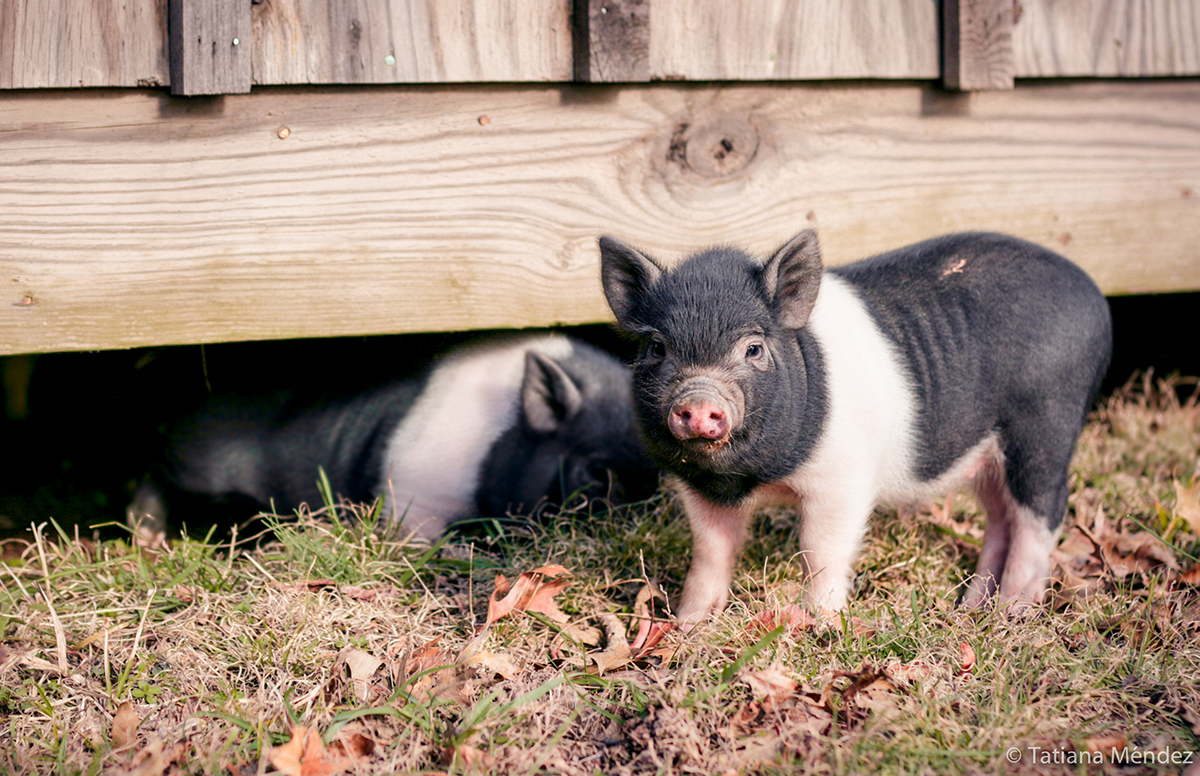
Sophie was sold on the side of the road by some Amish to a family who were told she was a Pot bellied pig. When it became obvious she wasn't (and would grow to be 800 lbs.!) they no longer wanted her. When their home went into foreclosure and their son became ill, they took the little pig to the shelter. A huge thanks to Maple Farm volunteer Cynthia Cruser, who lives in Rhode Island, drove up to Maine to retrieve her, then transported her all the way down to Poplar Spring. She is one of the very few lucky pigs, who will now know nothing but love for the rest of her life. From Poplar Spring Animal Sanctuary's Facebook Page.








The life of a breeding sow in the U.S. pork industry is one of extreme confinement, stress, and suffering. There were more than 5.8 million pigs used for breeding in the United States in 2011, most of whom were confined to gestation crates, typically lined up row after row in large sheds. These naturally curious and intelligent animals are first impregnated at 7 months of age and live out their lives in a cycle of pregnancy, birth, and nursing until they are eventually sent to slaughter.
- The majority of breeding sows spend nearly the entirety of each pregnancy confined to a gestation crate, which is only slightly larger than their body, making it impossible for them to lie down comfortably or even turn around.
- Standing on the hard, unnatural slatted flooring of a gestation crate takes a toll on pigs’ feet, causing excessive foot injuries, damage to joints, and even lameness.
Gestation crate floors are usually made of slats, which allow manure to fall through, meaning that sows live directly above their own waste. This design exposes sows to high levels of ammonia, and respiratory disease is common in confined sows.
- Standing on the hard, unnatural slatted flooring of a gestation crate takes a toll on pigs’ feet, causing excessive foot injuries, damage to joints, and even lameness.
- Shortly before piglets are born, sows are moved to “farrowing crates” where the piglets will be nursed. The crates, meant to separate the mother from the piglets to avoid crushing, are restrictive to the point that the mother pig can only stand and lie down — she cannot even turn around to see her piglets.
- At only 17–20 days old, the piglets are taken away from their mothers and undergo a series of mutilations, including being castrated and having a portion of their tails removed without any sort of pain relief. The piglets spend the next 6 months of their lives confined to pens until they reach “market weight”; they are then trucked to slaughter.
- Once piglets are weaned, their mothers are put back into the restrictive gestation crates and re-impregnated, and the cycle continues at an average of 2.1–2.5 litters per year until the sow is considered spent and is sent to slaughter herself.
On farm sanctuaries, pigs are playful and social; they enjoy running, socializing, relaxing, and playing in the mud. Like dogs, they recognize their names and come when called (if they like you). As scientific advisor to the British government Dr. Donald Broom explains, pigs “have the cognitive ability to be quite sophisticated. Even more so than dogs and certainly three-year-olds.”¹
Indeed, pigs are the smartest of the barnyard animals. As just one example, pigs have been taught to play video games. Wired reports that “pigs could be as smart as chimpanzees and other nonhuman primates,” says Stanley Curtis, former professor of animal sciences at Pennsylvania State University. Curtis says that the pigs learned to play games every bit as quickly as [chimpanzees]. In fact, “Hamlet and Omelette exhibited more interest in the task at hand than their primate cousins…”² Animal cognition researcher Dr. Sarah Boysen notes that “pigs are capable of focusing their attention with even more intensity than a chimp.”³
Similarly, pigs are also emotional beings, just like humans. For example, the UK daily The Independent writes that researchers “taught pigs to give one response when they felt normal and a different response when they were anxious (in this case, they were given a drug designed to induce temporary anxiety). Not only could the pigs discriminate between these two states but later they made the same ‘anxious’ response when exposed to novel events such as an unfamiliar pig or a new pig pen.”4
Finally, pigs are socially quite advanced, exhibiting methods of interaction with one another observed previously only in primates. A story from the Press Association titled “Pigs ‘share brain skills’ with humans and primates” discusses research from the University of Bristol (UK) that found that “pigs use their brains to outwit each other in much the same way as humans and chimpanzees. For instance, they were able to learn to follow other animals to desired items such as food before stealing away the prize. Victims of such thefts responded by behaving in ways that lessened the chances of being followed.” As Dr. Mike Mendl explained, “Our results suggest that pigs can develop quite sophisticated social competitive behavior, similar to that seen in some primate species.”5
From Farm Sanctuary's website.

